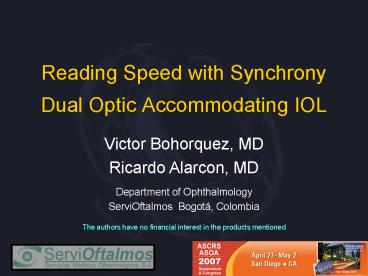Reading Speed with Synchrony Dual Optic Accommodating IOL - PowerPoint PPT Presentation
1 / 9
Title:
Reading Speed with Synchrony Dual Optic Accommodating IOL
Description:
... the MNRead chart was developed in Spanish. 25 patients implanted binocularly with Synchrony IOL ... 15 patients implanted with conventional monofocal IOLs ... – PowerPoint PPT presentation
Number of Views:35
Avg rating:3.0/5.0
Title: Reading Speed with Synchrony Dual Optic Accommodating IOL
1
Reading Speed with Synchrony Dual Optic
Accommodating IOL
Victor Bohorquez, MD Ricardo Alarcon,
MD Department of Ophthalmology ServiOftalmos
Bogotá, Colombia The authors have no financial
interest in the products mentioned
2
Methods
- A reading chart based on the MNRead chart was
developed in Spanish. - 25 patients implanted binocularly with Synchrony
IOL - 15 patients implanted with conventional monofocal
IOLs (AcrySoft) served as controls
3
Methods
- Measured through the best-corrected DISTANCE
visual acuity (BCDVA) at 40 cm. - No near Add power was used
- Measurements
- Reading Acuity (logRAD)
- Maximum Reading Speed (words/min)
- Reading speed at newspaper print size (logRAD 0.4)
4
Reading Speed at 40 cm Distance corrected, No
Near Add
The reading chart was developed in-house Based on
MNRead specifications 2 Words were specially
difficult for patients
5
Reading Acuity
6
Maximum Reading Speed
7
Reading Speed at 0.4 logRAD
Mean reading speed at 0.4 logRAD (newspaper print
size) was also significantly better in eyes with
Synchrony IOLs (160.6 words/minute) vs control
(23 words per minute). At this print size, 88
of Synchrony eyes could read at least 80
words/min vs 13 of controls.
p lt 0.0001, Students T test
8
Summary
- The maximum reading speed and reading acuity was
better in eyes implanted with Synchrony IOLs - Synchrony also showed excellent reading speed and
reading acuity at newsprint size, with 88 of
eyes reading at least 80 words/min
9
Summary
- This study demonstrates that Synchrony can
provide adequate near functional vision, without
compromising intermediate vision, or inducing
haloes - A new test for functional intermediate vision is
under development, and will be shown at upcoming
meetings



























![L 33 Light and Optics [3] PowerPoint PPT Presentation](https://s3.amazonaws.com/images.powershow.com/8062541.th0.jpg?_=20160818125)



